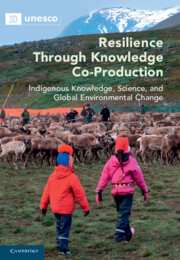 Resilience through Knowledge Co-Production
Resilience through Knowledge Co-Production from Part III - Global Change and Indigenous Responses
Published online by Cambridge University Press: 02 June 2022
Much of climate change policy treats indigenous peoples (if at all) as hapless victims rather than active participants in all components of climate change research, adaptation, mitigation and policy. Most Tibetans are cognizant of recent, rapid Himalayan climate change including rising temperatures, increasing and unpredictable precipitation, glacial retreat, glacial lake formation and outburst, and altering natural resources. Integrating scientific research with Indigenous knowledge leads to innovative perspectives and solutions. Our 1500 km (900 mile) transect across the eastern Himalaya, with intensive, long-term ecological alpine plant monitoring shows rapidly increasing plant richness, biodiversity and endemism, especially at higher elevations. Traditional ecological knowledge and economic policy often prescribe rival adaptations for Himalayan peoples; traditional culture and economics become competing paradigms by which to analyse the impacts of and adaptations to Himalayan climate change. We have even documented the appropriation and monetisation of successful Indigenous adaptations by government and economic entities to the detriment of the same Indigenous people who developed the strategies.
To save this book to your Kindle, first ensure no-reply@cambridge.org is added to your Approved Personal Document E-mail List under your Personal Document Settings on the Manage Your Content and Devices page of your Amazon account. Then enter the ‘name’ part of your Kindle email address below. Find out more about saving to your Kindle.
Note you can select to save to either the @free.kindle.com or @kindle.com variations. ‘@free.kindle.com’ emails are free but can only be saved to your device when it is connected to wi-fi. ‘@kindle.com’ emails can be delivered even when you are not connected to wi-fi, but note that service fees apply.
Find out more about the Kindle Personal Document Service.
To save content items to your account, please confirm that you agree to abide by our usage policies. If this is the first time you use this feature, you will be asked to authorise Cambridge Core to connect with your account. Find out more about saving content to Dropbox.
To save content items to your account, please confirm that you agree to abide by our usage policies. If this is the first time you use this feature, you will be asked to authorise Cambridge Core to connect with your account. Find out more about saving content to Google Drive.